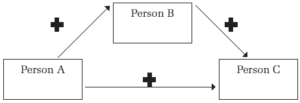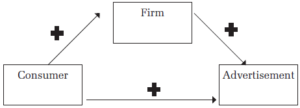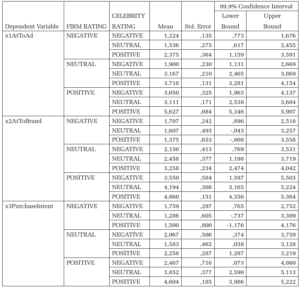Introduction
As we have covered in lecture, signed networks are networks that consist of positive and negative relationships (i.e. nodes connected to one another with edges a positive or negative value). And we say that a set of edges and nodes that form a triangle is balanced if it has one or three positive edges, and unbalanced if it has zero or two positive edges.
Yakut uses the concept the signed networks as a way to analyze the effectiveness of celebrity endorsements. For instance, if A is good friends with B, and B is good friends with C, then we can expect A will probably become a good friend of C (fig. 1). Using the same concept, if a consumer has a positive view of a firm, and a firm has a positive view of its own advertisement (perhaps a truism), then the consumer will probably be expected to have a positive view of the advertisement (fig. 2). Similarly, if a consumer has a positive view of a celebrity, then the consumer will probably be expected to have a positive view of the products they endorse. In the previous two examples, if the consumer has a negative view of the firm or the celebrity, then any advertisements with which they associate will probably not be effective. With this basic intuition, Yakut has done empirical research that would show when celebrity endorsements are most effective.

Fig. 1: Friend of a friend is a friend.

Fig. 2: Consumers that like a firm will probably like its advertisements.
Experiment
Before the experiment proper, 92 university students were asked to rate (possible choices being positive, neutral or negative) 24 firms, then 24 celebrities. With the feedback, four celebrity-endorsed advertisements were chosen which would likely correspond to the firm-celebrity reputation being positive-positive, negative-positive, positive-negative, and negative-negative.
Then, 191 students participated in the experiment proper. They assembled in one of four classrooms. All participants watched one of the four advertisements simultaneously. The following was the procedure:
- Participants were asked about their view on the firm by rating it a score of -5 to 5.
- Participants were asked about their view on the celebrity by rating them.
- Participants watched the advertisement.
- Participants were asked about their view on the advertisement by rating it.
In addition, to measure the effectiveness of a given celebrity endorsement, the experiment recorded the participants’ attitude toward the advertisement, attitude towards the brand, and their intention to purchase with a scale; these were categorized as dependent variables.
Analysis and Implication

Fig.3: Pre-existing attitude towards firms * pre-existing attitude towards celebrity
The results of the experiment (fig. 3) shows that if a consumer had a positive view of both the firm and celebrity involved in an advertisement, then the consumer’s view of the advertisement is greater than if the consumer only had a positive view of only one of them. Participants who had a double positive view has also shown, on average, to have a more positive view of the brand shown, as well as a greater willingness to purchase the product. This illustrates the principles of signed networks as we covered in class, as this is similar to the intuition that “a friend of my friend is my friend”, except perhaps we could say that this shows that “a friend of two of my friends is definitely also my friend.”
There are some practical implications of this experiment. First, advertisements with a celebrity endorsement are most effective when the consumer already has a positive view of the firm. Second, even if a consumer has a positive view of the celebrity doing the endorsing, it is ineffective as a way to compensate for the consumer’s negative view towards the firm behind the advertisement. Third, if a consumer approves of the firm doing the advertising but not the celebrity that endorsing the product, this only has a minor influence on the consumer’s view on the brand, advertisement, and intention to purchase. It appears that while we could have anticipated how the experiment would conclude by our a priori knowledge on signed networks, we would have had a harder time anticipating how much a consumer’s opinions would be influenced by their view on a firm as opposed to a celebrity. In other words, while we could have anticipated how the signed edges would be configured, we needed an experiment to show how much weight the edges would have.
Conclusion
The concepts of signed networks and structural balance offer us useful ways in which to understand existing positive and negative relations, and to anticipate whether new relations will be positive or negative. In the case of this research, it has been useful as a framework with which to understand when celebrity endorsements are most effective. Firms can take this knowledge into consideration when trying to maximize the effectiveness of new advertisement campaigns.
Reference
Yakut, E. (2017). Role of Balance Theory on Celebrity Endorsement: Effect of Pre-Existing Attitudes. Pazarlama Teorisi ve Uygulamaları Dergisi, 3(1), 1-22.